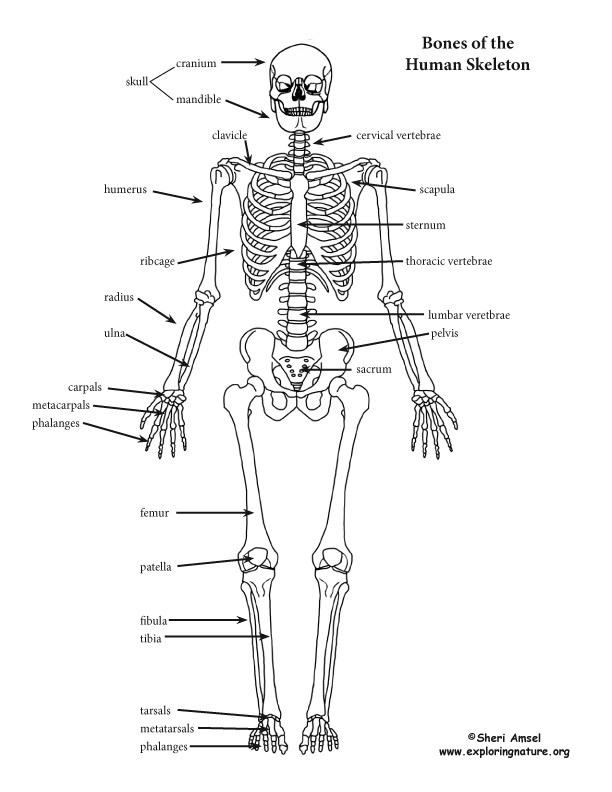

The skeleton forms the frame for the body and makes up about 1/5th of the body's weight. It is made up of 206 bones. It also includes cartilage, joints, and ligaments. Besides for forming our body frame the skeleton has several other jobs.
• It is the anchor and support for all our muscles and even our organs.
• It protects our vital organs like our brain, spinal cord, heart and lungs.
• It allows us to move with muscles attached by tendons using the bones as levers.
• It is a place for our body to store fat and minerals, like calcium.
• It is where the body makes most of its new blood cells.
Bones come in many shapes and sizes.
The long bones have a long shaft and two bigger ends. These include the bones of the arms and legs. The largest bone in the body, the femur, is a long bone. It is 2 feet long and hollow to make it lighter. It is very strong to support the body's weight.
The short bones are cube-shaped and include the bones of the wrist (carpals) and ankle (tarsals).
The flat bones are thin, curved and flattened like the sternum and skull.
Lastly, there are irregular bones like the vertebra and pelvis.
Each section of the skeleton has a job. Below see all the parts of the skeleton and how they work together to make the body a strong, moving machine.
To Learn about the Anatomy of Bone: Click Here
To Learn about Joints: Click Here
To Learn about the most common joints in the body - Synovial Joints: Click Here
For a Skeleton Labeling Page, hit the pdf below.
LS1.A: Structure and Function
• All living things are made up of cells, which is the smallest unit that can be said to be alive. An organism may consist of one single cell (unicellular) or many different numbers and types of cells (multicellular). (MS-LS1-1)
• Within cells, special structures are responsible for particular functions, and the cell membrane forms the boundary that controls what enters and leaves the cell. (MS-LS1-2)
• In multicellular organisms, the body is a system of multiple interacting subsystems. These subsystems are groups of cells that work together to form tissues and organs that are specialized for particular body functions. (MS-LS1-3)
When you research information you must cite the reference. Citing for websites is different from citing from books, magazines and periodicals. The style of citing shown here is from the MLA Style Citations (Modern Language Association).
When citing a WEBSITE the general format is as follows.
Author Last Name, First Name(s). "Title: Subtitle of Part of Web Page, if appropriate." Title: Subtitle: Section of Page if appropriate. Sponsoring/Publishing Agency, If Given. Additional significant descriptive information. Date of Electronic Publication or other Date, such as Last Updated. Day Month Year of access < URL >.
Amsel, Sheri. "An Introduction to the Skeletal System" Exploring Nature Educational Resource ©2005-2024. December 13, 2024
< http://www.exploringnature.org/db/view/Skeleton >
